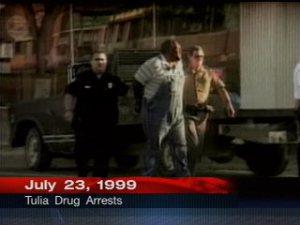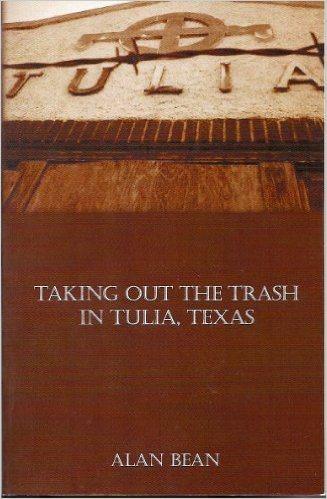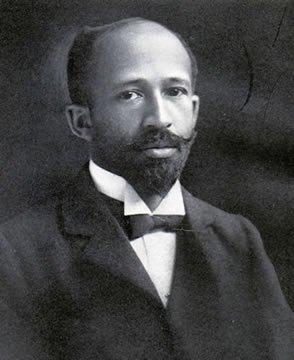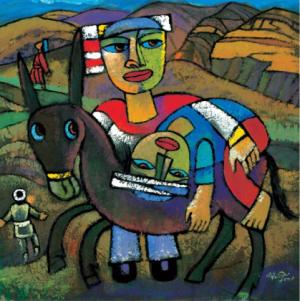These days, everybody seems to agree that mass incarceration–the policy of fighting crime by locking up as many people as possible for as long as possible–was a really bad idea. Charles and David Koch, Ted Cruz, and a steadily lengthening queue of criminologists and police chiefs have come out in favor of decreasing the American prison population.
It hasn’t always been this way. In fact, when Friends of Justice formed fifteen years ago, most opinion leaders in America saw incarceration as the solution, not the problem. Our work in places like Tulia, Texas and Jena, Louisiana helped change that perception.
But it will take more than a shift in the zeitgeist to significantly lower the prison population. The following address concluded the “Ties That Blind: Race and the Criminal Justice System” conference at the United Theological Seminary in Minneapolis on October 16, 2015. The little town of Tulia, Texas, I suggest, shows why mass incarceration looked like such a good idea at the time and why it will take a spiritual reformation to find a better solution.
By Alan Bean

In the early morning hours of July 23, 1999, officers from across the Texas panhandle converged on the south side of this community of 5,000. Before they were finished, 47 people were stuffed into the tiny holding cells in the Swisher County Jail. All but six of them were black, and those who weren’t had close ties with the black community.
Tom Coleman, a gypsy cop whose father was a legendary Texas Ranger, was responsible for buying 132 little baggies of white powder from these 47 defendants. Nothing connected the little baggies to the defendants save Coleman’s uncorroborated word. He had no second witness testimony, no audio or video evidence, no fingerprints and no guns, drugs or large amounts of cash were found in the course of the drug sweep.
You either believed Coleman was telling the truth or you didn’t.
I didn’t.
Maybe it was the way he bragged and strutted for the television cameras, or the fact that Sheriff Larry Stewart, who hadn’t witnessed a single illegal transaction, was so certain his undercover man was credible.
Patricia Kiker, my mother-in-law, read the feature article in the local paper, scratched her head and said, “Forty-seven drug king-pins in a town like Tulia? Who were they selling to, each other?”

Gary Gardner
My wife, Nancy, shared my suspicion, as did her father, a retired American Baptist pastor. And then there was old Gary Gardner, a Republican farmer who had hired many of the sting defendants back in the days when a small farm could support a family. Gardner, a man of prodigious girth, who was famous for filing law suits and for his inordinate love of profanity, had it in for just about everybody in Swisher County, the Sheriff in particular.
First, we took our questions to the black side of town. “Coleman didn’t even know half these people,” we were told, “and besides, there ain’t a black person in Tulia can afford powder; if people mess with cocaine its always crack. So where did all this powder come from?”
Then we talked to a sympathetic attorney who was representing six of the defendants. He told us that Coleman had been arrested in the middle of the eighteen-month Tulia operation on charges filed by his former boss, the sheriff of nearby Cochran County. Coleman was charged with theft, but his real crime was leaving town in the dead of night with $10,000 of outstanding debts. He owed money to just about every merchant in town.
With more red flags flying than a Bolshevik parade, Coleman was even named Texas Lawman of 1999 and the churches of Tulia served as unofficial cheerleaders for the drug bust. Tulia’s Christian community wanted drugs off the street and if that meant hiring a shady character like Tom Coleman, so be it. Defendants foolish enough to risk a jury trial were handed the stiffest penalties allowed by law, in one case six consecutive 99-year sentences.

The Tulia drug scandal (as it was now known) attracted the attention of 60 Minutes, People magazine, the New York Times, the Washington Post and just about every other media outlet you can imagine. The big question was how, and why, so many people had been willing to believe Tom Coleman’s uncorroborated claims. Everyone agreed that Coleman had been motivated by a toxic mix of greed and racism; but it was harder to explain why Swisher County’s Sunday school-teaching Sheriff had proved so gullible or why the churches of Tulia had embraced the sting with such unholy zeal.
I kept telling reporters that Tulia was America writ small. For me, this was a fresh insight. When our fight for justice began in 1999, I knew next to nothing about mass incarceration. If you had told me then that the American incarceration rate was six times that of my native Canada, or seven times greater in 1999 than it had been in 1972, I wouldn’t have believed you.
I didn’t know that there were only 16 state prisons in Texas in 1980 and 108 twenty years later.
But once we decided to stand with the Tulia defendants, I started reading everything I could get my hands on that might help me make sense of the bizarre facts I was witnessing, and my research convinced me that, far from being an isolated throwback to Jim Crow era racism, Tulia was America in miniature.
While our fight was still in progress, I spent hundreds of hours at the local library reading old microfilm editions of the Tulia Herald. The librarian knew I was up to something nefarious, but she was never sure what. And I started asking family members of the sting victims to give me a black perspective on Tulia’s history, a subject they never tired of discussing.
I learned that Tulia was pretty much an all-white town until irrigated agriculture transformed the Texas panhandle into an agricultural wonderland. Starting in the late 1940s, black sharecroppers from Deep East Texas began migrating to little towns like Tulia in search of steady work and a better life. White farmers in Swisher County were building four bedroom homes and the modest homes they left behind were jacked up and hauled to a rapidly growing colony of shacks on the west side of the Tulia tracks. When they ran out of shacks for people to live in, railway cars were pressed into service. The resulting community was called the Sunset Addition.
To my surprise, black residents remembered “Sunset” of “the Flats”with great fondness. At first, it was hard to see why. There was never enough heat in the winter and no air conditioning in the blistering hot panhandle summers. I was amazed to learn that two simple spigots provided drinking, washing and bathing water for over 400 people. That number would grow to over 1,000 on the weekends when black families from all over the panhandle converged on Sunset to dance, drink and play poker and pool in the string of bootleg bars strung out along Front Street.
People had a few dollars to spend because work was plentiful and wages, though pitifully low by contemporary standards, beat the hell out of sharecropping. Enterprising Sunset residents made money on the side as loan sharks, card sharks and bootleggers. Or, more legitimately, you could make good money buying old beat-up trucks and organizing work crews for the white farmers.
Sunset, as you might expect, could be a violent place, and when a shooting or a stabbing went down the body just lay on the floor until Monday morning. Swisher County only had four police officers in 1950, and they certainly weren’t going to waste their time in Sunset. Arrests were rare and every killing was ruled self-defense. If a field hand got arrested for fighting or gambling, his white boss would tell the Sheriff to cut him loose—with agriculture booming, every hand was needed.
In theory, an undercover agent could have busted half of Sunset for one crime or another on any given weekend; but with labor desperately scarce, that thought never crossed anybody’s mind.
The Sunset Addition had its own separate-but-equal school, of course, and it was commonly assumed that black folks (the polite expression) had no need for an education beyond Junior High. Black maids crossed the tracks for work, but you didn’t want to be in a white neighborhood after dark. They called it “Sunset” for a reason.
Beginning in 1975, the agricultural economy of Swisher County began to unravel. Commodity prices were dropping while the cost of production shot through the roof. After three decades of profligate pumping, the waters of the Ogallala Aquifer were drying up. As a few big farmers bought up all the arable land, hundreds of families gave up and moved to town.
By almost any measure, conditions had improved for Tulia’s black residents by 1999, the year of the drug sweep. The Sunset Addition had been condemned and bulldozed so white ex-farmers could cash in on HUD money and FHA loans. Low income housing wasn’t pretty, but it came with showers, bathtubs, flush toilets, heat in the winter and, come summer, a second-hand air conditioning unit rattling in the living room window.
Tulia’s schools were fully integrated by 1970. There were few complaints when black students started attending high school; it was good for the sports program. Gifted athletes, regardless of color, were celebrated by the local community, and as black became the color of cool, white girls started paying attention to the black boys who dunked the basketball and scored the touchdowns on Friday nights.
It was assumed that, black or white, graduation meant leaving town—Lord knows, there were no jobs on offer in Tulia. Swisher County’s corps of four officers in 1950 had swelled to forty-eight by 1999, and the folks in Swisher were banding together with 25 other counties to form the Panhandle Narcotics Trafficking Task Force, an operation funded by the federal Byrne Grant program.
The orgy of prison construction that engulfed Texas throughout the 1980s, accelerated in the 1990s when Tulia, after several failed attempts, finally got a prison west of town. Failed farmers who couldn’t imagine living anywhere other than Swisher County, looked to the criminal justice boom for work. By 1999, both the sheriff and the district attorney were failed farmers.

W.E.B DuBois
Writing in the late 19th century, a young W.E.B. DuBois noted that when “in a land of freemen, eight millions of human beings were found to be dying of disease, the nation would cry with one voice, “Heal them!” If they were staggering on in ignorance, it would cry, “Train them!” If they were harming themselves and others by crime, it would cry, “Guide them!” But if the victims of poverty and ignorance had black skin the cry was very different: “Let them die!” “Train them like slaves!” “Let them stagger downward!”
This ancient double-standard played out in Tulia, and across the nation, with remorseless uniformity. Making work for white prosecutors, police officers and prison guards was the Texas version of “Heal them, train them, guide them.” But, applied to the sons and grandsons of black field workers, the criminal justice boom translated into a different cry: “Let them die!” “Train them like slaves!” “Let them stagger downward!”
Why were the churches of Tulia, conservative and moderate, black, white and brown, unable to realize that a blatant injustice was being perpetrated under their very noses? Deep down, they had to know that Tom Coleman couldn’t be trusted, but they didn’t care.
I am reminded of Jesus’ story of the Good Samaritan. The story was inspired by “a lawyer” who wanted to know the secret to eternal life. Jesus didn’t say “believe in me as your personal Lord and savior and you will be saved.” Instead, he went old school. “What is written in the law?”
“You shall love the Lord your God with all your heart, and with all your soul, and with all your strength, and with all your mind; and your neighbor as yourself.”
But the lawyer, “seeking to justify himself” asked for a precise definition of “neighbor”.
To make the situation as concrete as possible, Jesus told a story about a man who was attacked by robbers, beaten, stripped naked and left for dead. A priest and a Levite come upon the scene and immediately pass by on the other side.
Jesus didn’t reveal the ethnicity of the naked man bleeding by the side of the road. Since he was naked and unconscious, there was no way for these men of the cloth to know whether they were dealing with a Jew or a Samaritan, they just knew he was trouble.

The victim was probably traveling at night and deserved what he got. Maybe he was trying to rob someone else and got mugged in the process. Maybe he got into a fight with another n’er do well over money or a woman and ended up on the short end of the stick. In other words, they would have done whatever it took to justify their own hardness of heart. The simple fact was that they didn’t see the wounded man as a human being; they saw him as a threat to their well-being and they responded accordingly.
And that’s what happened in Tulia. And that is what has been happening across our nation since the machinery of mass incarceration started grinding in the early 1970s. The raids weren’t happening in our neighborhood. If the prison population was disproportionately African American, well, we know how those people are.
And this is why ending mass incarceration is going to take a long, long time. It can’t happen until Middle America embraces poor black people as children of God and American citizens in good standing. We are a long way from that blessed goal.
A couple of years ago, I was invited to a convening on mass incarceration in Washington D.C. The participants were all people of faith, mostly Christian, and the organizers of the event wanted us to tell them how the churches of America could help end mass incarceration.
This was the second time the group had come together and the organizers were looking for a concrete plan. We broke into small groups and were asked to come up with a goal. After two hours of back and forth, the group decided that their goal would be to end mass incarceration in two calendar years.
I understand the importance of building “group effervescence”. Sometimes it doesn’t matter what the group decides; it’s the process that counts. But there always seems to be one jerk in every group and, since nobody else seemed willing to play that role, the onus was on me. “Since it has taken over half a century to build mass incarceration,” I asked, “why do we think we can end it in two years.”
I was informed that a recent study concluded that, if every public official in America was committed to ending mass incarceration, it would take about two years to repeal all the bad legislation, release all the prisoners, and reform the court system.
Unfortunately, I pointed out, our public officials are not committed to ending mass incarceration, so the two-year time frame was pure fantasy. That didn’t win me a seat at the cool kid’s table.
There are two giant obstacles to ending mass incarceration. As Michelle Alexander has persuasively argued, millions of Americans working as attorneys, judges, bails bondsmen, police officers, prison guards, construction workers owe their living to the prison boom. Investors have poured billions of dollars into private prisons and they won’t walk away from their investment without a fight.

Ta-Nehisi Coates
Secondly, mass incarceration was a public policy response to a great American wealth gap which divides largely along racial lines for stark historical reasons. As Ta-Nehisi Coates told Gwen Ifill on PBS earlier this week, “For every dollar of wealth that a white family has, African American families have a nickel. That is not a mistake. That is not the result of magic. That is the result of done policy.”
If the history of Tulia, Texas is America writ small, it’s not hard to see why the wealth gap exists or how it has created what Coates calls “a tangle of perils” for black families. Until these families are embraced as children of God and American citizens in good standing mass incarceration, or something worse, will be necessary to keep the lid on. We may see a modest decline in incarceration rates, but the demographics of the prison population will not change.
And that’s why Ta-Nehisi Coates is calling for reparations. He isn’t talking about checks in the mail, he’s talking about pouring investment and resources into poor communities the same way we sucked them out. He’s talking about the creation of meaningful work whether or not it makes economic sense to the people living in outer ring suburbs. He knows there is little political or religious will for changes this sweeping, so he doesn’t think reparations will be paid; he’s just saying they should be paid, and he’s right.
We could end mass incarceration in two years if every public official in America was down with the project. And we could get the churches of America behind that that devout purpose if every American suddenly embraced the stated agenda of Jesus. What will it take to get the churches thinking like their Master? Nothing short of a theological revolution will turn the trick. And here and there, you can see the first flowering of that revolution. The gracious, Jesus-shaped words of Pope Francis are so encouraging, even to non-Catholics like me. People of faith are shedding their ancient prejudice against the LGBT community. Young people are noticing the message gap between Jesus and his most prominent followers and asking why.
Nothing will come quickly or easily, but a new kind of politics and a new kind of Christianity is struggling to find a voice. This event may sound like a voice crying in the wilderness but, in our own quiet way, we are preparing the Way of the Lord.
